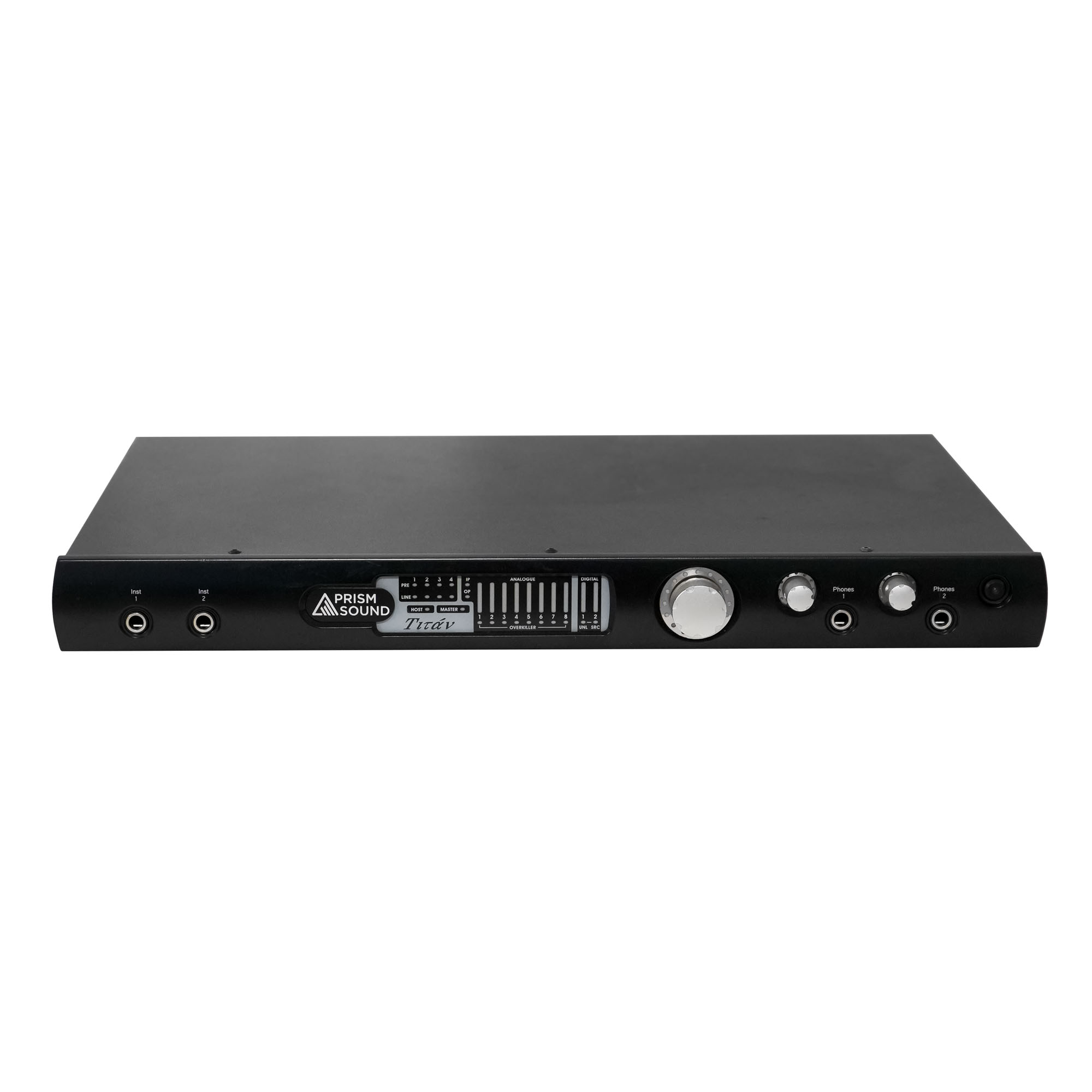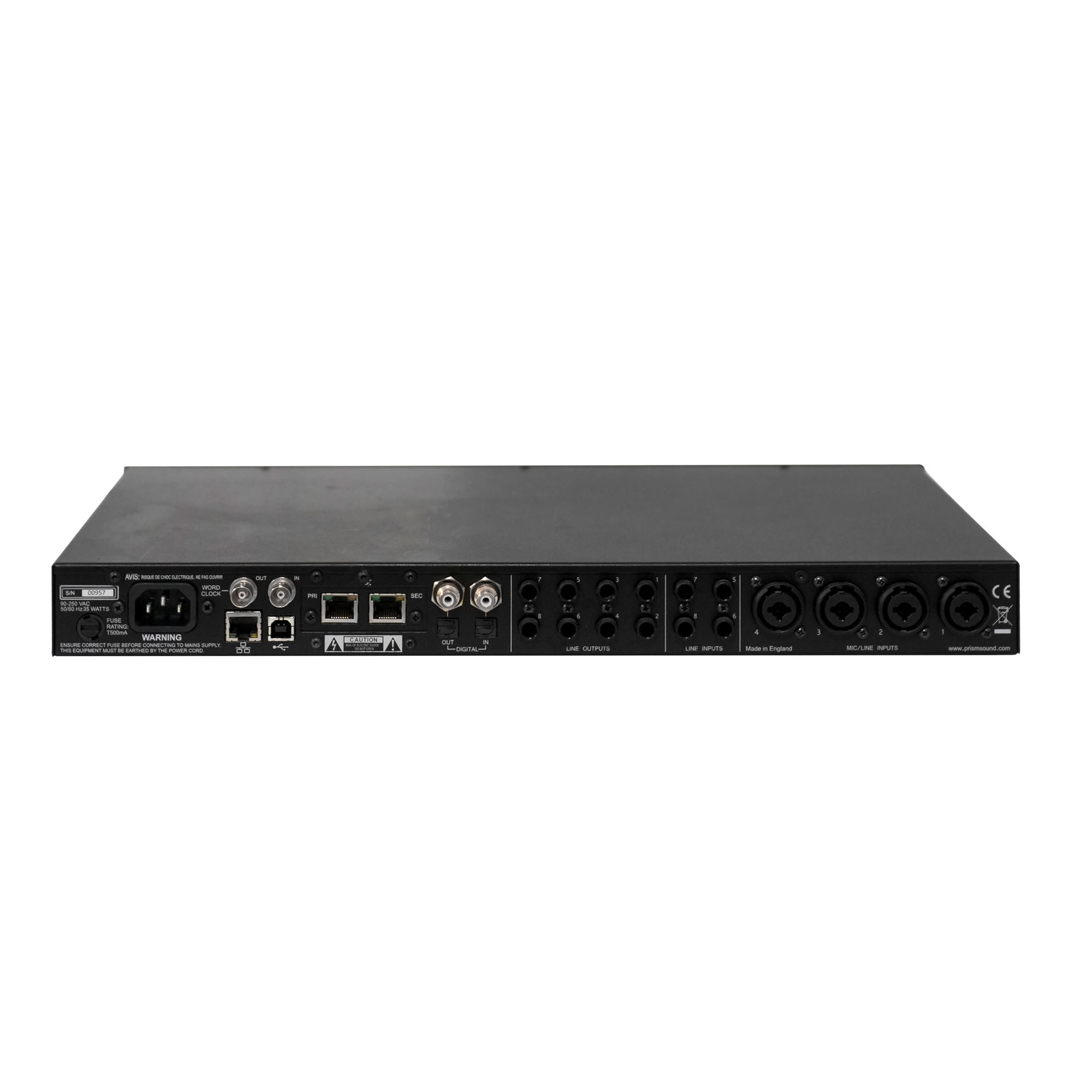Prism Sound Titan USB Audio Interface with DANTE
The Prism Sound Titan is a USB 2.0 audio interface based on the highly popular Orpheus and features 8 analogue I/O including 4 high-grade mic pres and 2 Hi-Z instrument inputs, 8 optical digital I/O and 2 S/Pdif / AES I/O. The Titan by Prism sound features the same outstanding and proven performance of its predecessor but boasts in addition a MDIO slot to accommodate digital interfaces adding further compatibility including Pro Tools HDX, AES and Thunderbolt.
Titan is ideal for music and sound recording, multitracking, overdubbing, stem-based mastering, analogue summing and critical listening applications.
Titan provides Prism Sound’s renowned performance, sound quality and state-of-the-art clock technology in a dedicated unit compatible with both Windows (Vista and higher, 32 and 64 bit) as well as Mac OS X 10.5 and later (Intel). Once configured with a computer, Titan can also operate stand-alone using its S/PDIF or AES3 I/O.
Like Prism’s flagship ADA-8XR and its range of converters, the Titan is a no-compromise unit featuring only the best components available to offer the best possible conversion.
Verifile
Verifile is a radical new proprietary technology exclusive to Prism Sound which allows computer audio streams and recorded files to be quickly checked for a wide range of clicks, errors and dropouts, without any compromise in the audio content or any additional metadata.
Standards compliant USB interface
Prism Sound has taken on board the increasing importance of native processing power for professional users and the fact that software products for standard PC and Mac platforms have been greatly enhanced in recent years. Titan uses a USB2 interface. This is a UAC2 (USB Audio Class 2) interface supported natively in Mac, iPad, Linux and Android, and in Windows via a driver.
Multichannel Digital Input and Output (MDIO) expansion
Atlas & Titan support Prism Sound’s MDIO expansion cards, which provide alternative “host” connections. The “host” is usually a computer and the Atlas or Titan interface provides a means of connection between the host and the external analogue and digital audio I/O ports.
Without the MDIO expansion card fitted, the host connection would always be the default USB connection.
The MDIO expansion slot provides an alternative host connection. It does not necessarily disable the USB port, but in the case of the Pro Tools interface MDIO-PTHDX, the USB port is switched off when the Pro Tools interface is to be used.
Currently, only the MDIO-PTHDX expansion card is available. Others may be produced later.
Flexible Inputs and Outputs
Our customers told us that many professional users wanted a highly integrated solution with instrument and microphone inputs, and line outputs that could be used for stereo or multi-channel monitoring and/or foldback to performers. Titan offers eight analogue recording channels, eight monitoring outputs, stereo digital input and output on a phono connector plus concurrent optical digital I/O ports that can interface to S/PDIF or ADAT data formats, giving Titan a maximum capability of 18 concurrent input and output channels plus stereo headphones.
Digital Mixer
Our customers also identified a need for a unit that could provide low latency foldback to performers, particularly when tracking and overdubbing. In answer to this need, Titan has a powerful built-in digital mixer that can be configured from the host computer to provide foldback feeds to performers, each with their own stereo mix of workstation playback and any of the inputs.
Flexible Monitoring and 5.1 capabilities
Professional users demand more sophisticated monitoring capabilities and are getting used to surround sound with HDTV and DVD, so it is becoming important to support surround monitoring setups.
As well as wanting great analogue recording channels, the DAW user also needs top-quality monitoring. The eight analogue outputs on Titan allow monitor setups from multi-stereo up to 7.1 surround. Titan has a real volume knob which can be assigned to any or all of the analogue or digital outputs for use as a control room monitor control. There are two headphone amps, suitable for all types of headphones, each with its own independent volume control. As well as having its own workstation feed and mixer, the headphones can also be quickly switched across the other output pairs, which is handy for setting up.
Sample Rate Conversion and Noise Shaping
The digital output is equipped with the four Prism Sound SNS noise-shaping curves and includes Prism Sound’s renowned synchronous sample-rate conversion, allowing outputs to various external devices at other sampling rates. The sample-rate converter can be used at the outputs as well as the inputs, so as well as dealing with unsynchronised or wrong-rate digital inputs, Titan can also generate, say, a live 44.1kHz output from a 96kHz session. Since Titan also includes the full suite of the famous Prism Sound ‘SNS’ noise shapers, you can also reduce to 16-bits at mastering-house quality.
Unsurpassed Jitter Rejection
In the 1990s Prism Sound pioneered testing of sampling and interface jitter and as a result our digital audio products deliver unsurpassed jitter rejection. Prism Sound digital audio products lock up fast and re-generate ultra-stable clock outputs. Another aspect of the traditional Prism Sound converter that is retained was the clocking – it’s just as important as analogue-path considerations sound-wise. So whether it’s providing a high-quality master clock for the rest of the room, or dealing with a jittery clock from outside, Titan is as rock-steady as its forbears.
Overview:
- 8x analogue line I/O
- 4 high-grade mic pres (with switchable mic pads) 2 high impedance instrument inputs
- 8x optical ADAT I/O (or 4x SMUX, 2x TOSlink)
- 2x SPDIF/AES I/O
- 2x Headphone outputs (sharing a single stereo bus)
- MDIO slot for optional digital interfaces
- Ethernet port (for future potential AVB and networking integration)
- Wordclock I/O
- USB 2.0 host
- Mac OS X and Windows drivers included
Specifications
FRONT PANEL
- Instrument Inputs 2 x 6.3mm mono jack sockets, auto-select to analogue inputs 1 & 2 when plugged
- Headphone Outputs 2 x 6.3mm stereo TRS Jacks, each with illuminated volume control
- Master volume Assignable encoder / push switch with halo indication
- Standby button with standby indicator (also flashes when unit is in ‘identify’ mode)
Indication:
- Level Meters 10 x multi-segment bargraphs with overload indication, 8 for analogue, 2 for digital, assignable to inputs or outputs
- Input selection Indicate mode of analogue inputs 1-4 as Mic / line / inst & plus phantom power indicator for mic mode
- Overkiller For every analogue input, lit when Overkiller limiters are acting
- Digital Input indicators for digital input unlocked and SRC (sample-rate converter) selected
- Digital Output indicator for SRC (sample-rate converter) selected
- Sync Master indicator, lit when interface is providing system sync
REAR PANEL
- Mic / Line inputs 1-4 4 x combo connectors with XLR sockets for mic input and 6.3mm TRS jack sockets for line input (balanced or unbalanced)
- Line inputs 5-84 x 6.3mm TRS jack sockets (balanced or unbalanced)
- Line outputs 1-8 8 x 6.3mm TRS jack sockets (balanced or unbalanced)
- Digital inputs
1 x RCA
1 x TOSLINK for S/PDIF or ADAT Optical input;
(RCA can operate as AES3 input using XLR-RCA adapter supplied) - Digital output 1 x RCA 1 x TOSLINK for S/PDIF or ADAT Optical output; (RCA can operate as AES3 output using XLR-RCA adapter supplied)
- Wordclock 2 x BNC sockets, output and input (75R)
- USB port 1 x USB 2 port
- Ethernet port For future expansion / AVB
SOFTWARE SUPPORT
- Mac OS Support OS X 10.4 or later, Intel platform
- Windows OS Support Windows Vista, 7 or 8, 32 or 64 bit
- Mac audio driver Core Audio device
- Windows audio driver ASIO device
- Control Panel applet Graphical user interface for control of single or multiple Titan units under Mac OS X or Windows.
ANALOGUE LINE INPUTS
- Configuration Electronically balanced, with fully-balanced analogue signal path
- Input Sensitivity Switchable ‘+4dBu’ (0dBFS = +18dBu) or ‘-10dBV’ (0dBFS = +6dBu)
- Input Impedance 14.5kΩ
- Unbalanced Mode Automatic
- Total harmonic distortion -117dB (0.00014%, -0.1dBFS)
- THD+N -111dB (0.00028%, -0.1dBFS)
- Dynamic Range 116dB (-60dBFS)
- Gain Accuracy ±0.05dB
- LF roll-off -0.05dB at 8Hz; -3dB at 1Hz
- HF roll-off fs = 44.1kHz: -0.05dB at 21.1kHz; -3dB at 22.0kHz
fs = 48kHz: -0.05dB at 23.0kHz; -3dB at 23.9kHz
fs = 96kHz: -0.05dB at 32.0kHz; -3dB at 47.9kHz
fs = 192kHz: -0.05dB at 32.0kHz; -3dB at 78kHz - CMRR 20Hz..20kHz: >70dB
- Inter-channel cross-talk 1kHz: 140dB; 20Hz..20kHz: -120dB
- Inter-channel phase10Hz..5kHz: ±0.25°, 5kHz..20kHz: ±1.0°, 20kHz..50kHz: ±2.0°,
- Overkiller Progessive limiter, auto-aligning, selectable per channel
- Impact Filter High-pass filter, -3dB at 80Hz, 40dB/decade (selectable for channels 1-4; whether in line, mic or instrument mode)
- RIAA de-emphasis filterResponse accuracy: ±0.22dB at fs=44.1kHz; ±0.14dB at fs=48kHz; ±0.015dB at other sample rates
- M-S matrix Allows direct connection of mid-side mics, or non-matrix mic-preamps (selectable for channels 1-4; whether in line or mic mode)
MICROPHONE PREAMPLIFIERS
-
- Configuration Electronically balanced, with fully balanced analogue signal path
- Gain 10dB to 65dB in 1dB steps (0dBFS = -56dBu to -1dBu) plus switchable -20dB pad
- Gain accuracy ±0.05dB
- Input impedance 5.5kΩ
- THD +10dB gain: -116dB at -0.1dBFS (0.00016%)
+40dB gain: -110dB at -0.1dBFS (0.00032%)
- THD+N +10dB gain: -108dB at -0.1dBFS (0.00040%)
- Equivalent input noise (EIN)
+30dB gain: -128.5dBu (0Ω source); -126.3dBu (150Ω source)
+40dB gain: -130.9dBu (0Ω source); -127.6dBu (150Ω source)
+50dB gain: -131.2dBu (0Ω source); -127.7dBu (150Ω source)
+60dB gain: -131.4dBu (0Ω source); -127.8dBu (150Ω source) - LF roll-off -0.05dB at 20Hz, -3dB at 5Hz
- HF roll-off As per analogue line input data (dependent on fs)
- CMRR
50Hz/60Hz: >110dB at all gains
1kHz: >100dB at all gains
20kHz: >90dB at all gains - Phantom power +48V, switchable per channel
- Pad -20dB, switchable per channel
INSTRUMENT PREAMPLIFIERS
- Configuration Unbalanced, high impedance buffer
- Gain 10dB to 65dB in 1dB steps, 18dB pad (0dBFS = -38dBu to 17dBu)
- Gain accuracy ±0.05dB
- Input impedance 1MΩ
ANALOGUE OUTPUTS
- Configuration Electronically balanced, with fully-balanced analogue signal path
- Output amplitude Switchable ‘+4dBu’ (0dBFS = +18dBu) or ‘-10dBV (0dBFS = +6dBu)
- Output impedance 100Ω balanced, 50Ω unbalanced
- Unbalanced mode Automatic, with bootstrapping level compensation
- Total harmonic distortion -107dB (0.00045%, -1dBFS)
- THD+N -106dB (0.00050%, -0.1dBFS)
- Dynamic range 115dB (-60dBFS)
- Gain accuracy ±0.05dB
- LF roll-off -0.05dB at 8Hz, -3dB at 1Hz
- HF roll-off
fs = 44.1kHz: -0.05dB at 21.4kHz; -3dB at 22.0kHz
fs = 48kHz: -0.05dB at 23.2kHz; -3dB at 23.9kHz
fs = 96kHz: -0.05dB at 32.0kHz; -3dB at 47.8kHz
fs = 192kHz: -0.05dB at 32.0kHz; -3dB at 76kHz - Output balance >50dB
- Inter-channel cross-talk 1kHz: -135dB; 20Hz..20kHz: -120dB
- Inter-channel phase 10Hz..5kHz: ±0.4°, 5kHz..20kHz: ±0.25°, 20kHz..50kHz: ±0.5°,
DIGITAL INPUTS
- Formats supported S/PDIF (RCA or TOSLINK), ADAT, ADAT S/MUX (TOSLINK)
- Sample rates supported
S/PDIF (2 channel): 44.1, 48, 88.2, 96, 176.4 and 192kHz
ADAT (8 channel) 44.1 and 48kHz
ADAT S/MUX (4 channel): 88.2 and 96kHz - Channel Status ignored
- Word-length 24 bit
- AES3 operation via S/PDIF RCA, using RCA-XLR adaptor (supplied)
- Sample-rate converter (SRC)Selectable at S/PDIF input; allowing input at any sample rate
- Bit transparency Ma

